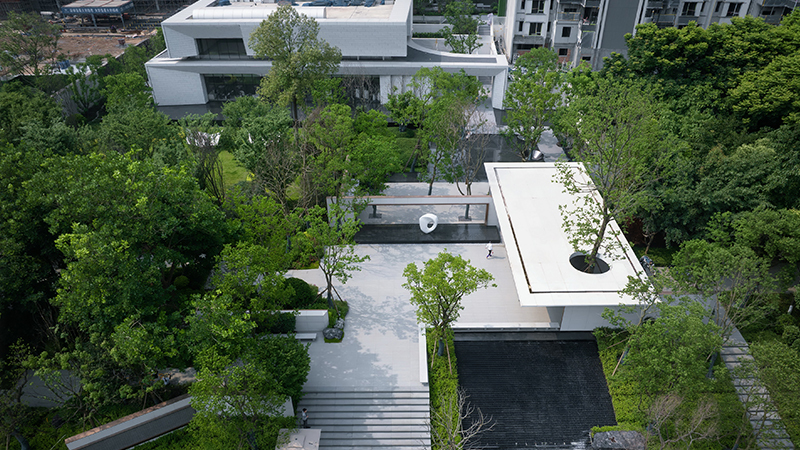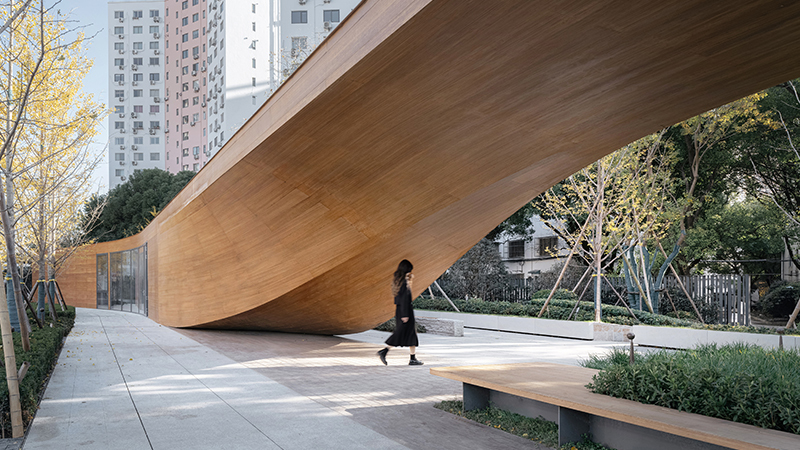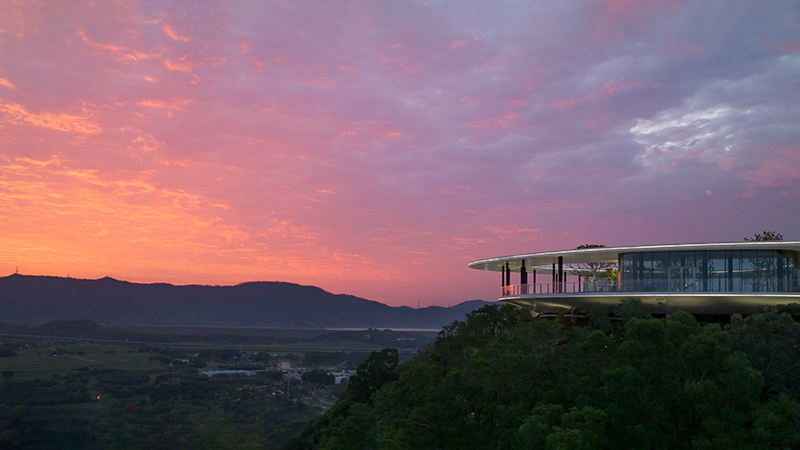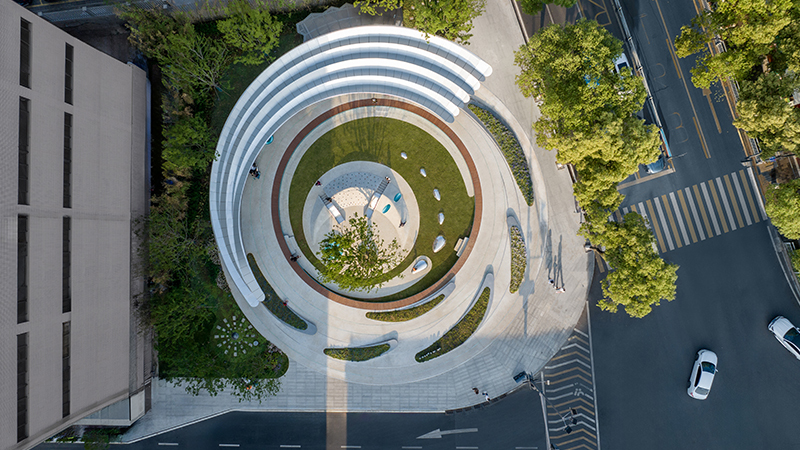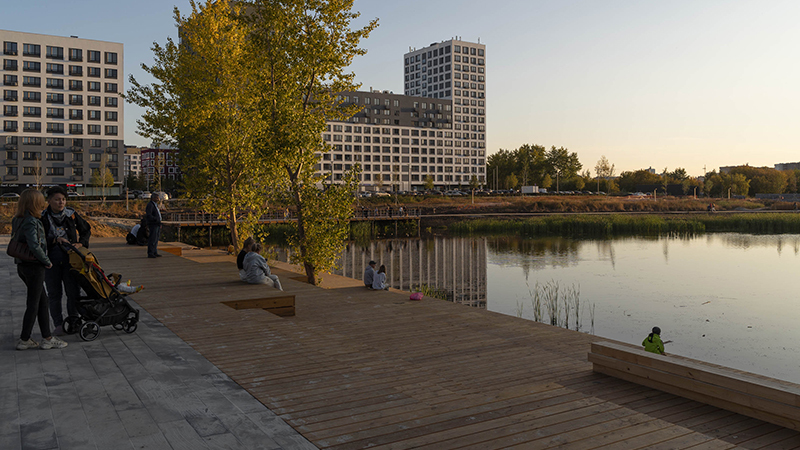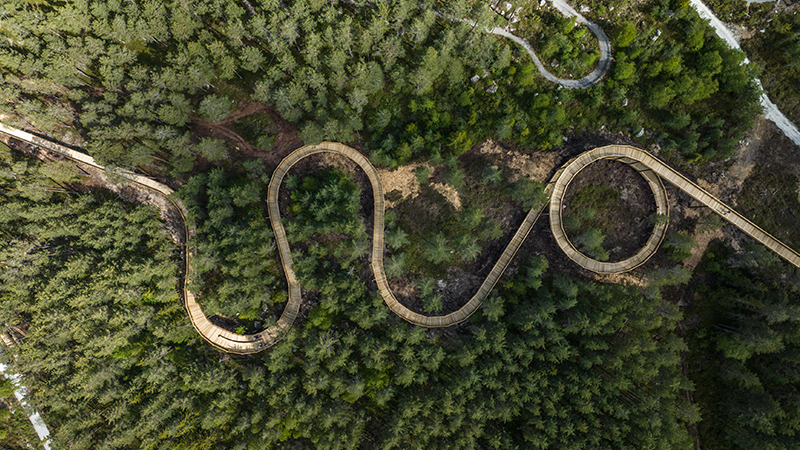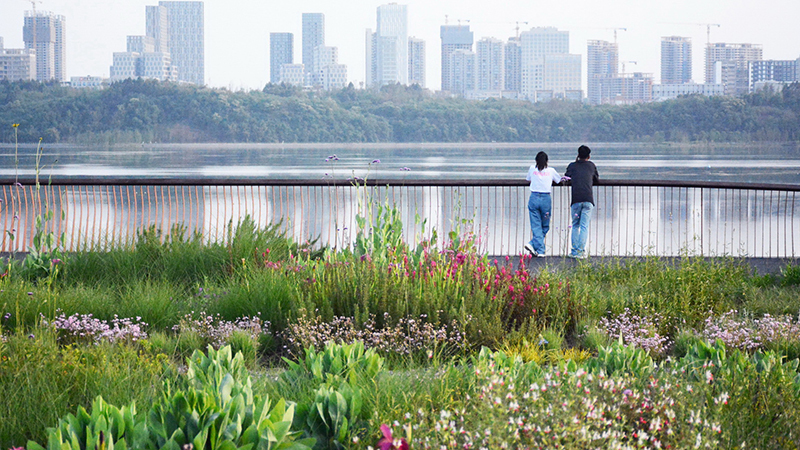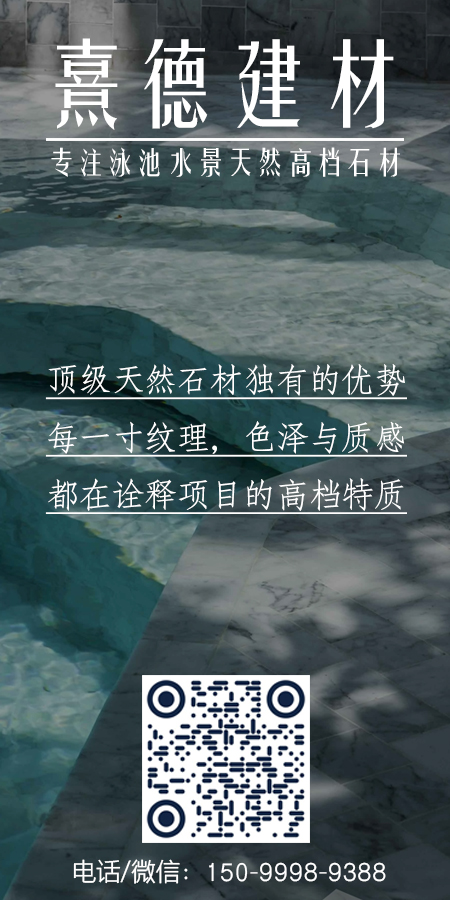引言
Introduction
坐落于城市山野浅丘地貌的麓野公园,是成都平原典型的土地肌理,经10余年演变,逐渐形成自然生境下的植被覆盖,成为具有遗留原始植被特征的自然山野空间,享受自然赠予的丰富多彩和无限畅想。
麓野公园发挥它支持生物多样性的潜力,坚守住了城市与自然的动态平衡。当我们掀开这块蒙尘的绿毯时,我们选择保留它原始的、野性的美。
Nestled within the rolling foothills of the city, Green Field Park is a living reflection of the Chengdu Plain's characteristic land texture. Over more than a decade of natural evolution, this area has gradually developed a spontaneous vegetative cover, forming a mountain landscape that still retains traces of its original ecosystem — a wild, untamed space gifted by nature, full of vibrant possibilities and boundless imagination.
Green Field Park embraces its potential to support biodiversity, maintaining a delicate and dynamic balance between city and nature. As we lifted the dust-covered green veil of this place, we chose to preserve its original, untamed beauty.
01-项目背景
PROJECT BACKGROUND
既是城市的,也是自然的
01 -Project Background
Both Urban and Wild by Nature
麓野公园位于麓湖生态城南部湖区,呈狭长形态,占地约7万㎡,作为麓湖水城和城市道路之间的公共绿地,紧邻仙踪公园航道水系,连接多个居住组团。
从卫星图上看,这片区域历经十余年的自然演变,已从原有废弃农田逐步转化为浅丘山地,茂密的植被像天然屏障般包裹着场地,在城市发展进程中始终保持着原始生态面貌。因其幽深的丛林环境,平时鲜有人深入其中。
Green Field Park is located in the southern lake district of Luxelakes Eco-City, forming a narrow strip of land covering approximately 70,000 square meters. Serving as a public green space between the Luxelakes Water City and the urban roadway, it borders the Xianzong Park waterway and connects multiple residential clusters.
Viewed from satellite imagery, this area has undergone over a decade of natural transformation—from once-abandoned farmland into a landscape of gentle hills. Dense vegetation now envelops the site like a natural barrier, preserving its primal ecological character amid the city's expansion. Due to its secluded forested environment, the area remains largely unexplored by the public.
△ 场地历史时空变化/Historical spatiotemporal changes
城市公园作为中国城市绿地系统的重要组成部分,正逐渐成为生物多样性保护的关键载体。为充分挖掘场地的生态潜力,自2024年6月起,万华和乐道携手麓湖社区基金会 、城市生物多样性共学计划,对这片山地展开了系统性调研。
场地内植被繁茂,林下生态系统良好,地势自南向北逐级递降,雨水在低洼处汇集,形成两处天然水塘,水质清澈。独特地势和森林覆盖率造就了场地独特有的微气候,更形成了一座自维持的生态宝库。经团队实地监测,场地内分布有117种原生植物、29种鸟类,其中包括城市稀客叉尾太阳鸟。这些鲜活的生态数据让我们意识到,这里并非是一片荒地,而是一条仍在生长的绿廊,是城市稀缺且珍贵的生态据点。
Urban parks are becoming key carriers for biodiversity conservation in China’s green space system.Since June 2024, Vanke, Ledo, the Luxelakes Community Foundation, and the Urban Biodiversity Co-learning Initiative have launched a systematic study of this mountain site to tap into its ecological potential.
With dense vegetation and a healthy forest floor ecosystem, the terrain descends stepwise from south to north, forming two clear natural ponds in its lowlands. This unique topography and canopy cover create a self-sustaining microclimate—an urban ecological reservoir.
Field research has recorded 117 native plant species and 29 bird species, including the rare-for-the-city Fork-tailed Sunbird. These findings revealed this is not a wasteland, but a growing green corridor—one of the city’s scarce and valuable ecological strongholds.
 |  |
 |  |
△ 场地现状/Current situation analysi
 |  |  |
 |  |
△ 原生物种观察/Species observation
02-设计应答
DESIGN STRATEGY
克制介入,顺势而为
02 – Design Strategy
Light Intervention, Following Nature’s Lead
鸟儿和植被自主择定的栖居地,往往比图纸更懂自然的尺度。基于前期调查结果,我们将其划分为两类空间:自然栖息区、自然接触区,对应不同的保育与管理模式。在回应生态保护的同时,也探索了公园作为城市开放空间的公共性、多样性与可持续性的实践。
The habitats chosen by birds and plants often understand the scale of nature better than any blueprint. Guided by preliminary research, we divided the site into two zones: a Natural Habitat Zone and a Nature Encounter Zone, each with distinct approaches to conservation and management. While responding to ecological protection, the design also explores the park’s role as a public, diverse, and sustainable urban open space.
△ 场地空间划分/Space division of the venue
整体遵循“留—隐—退”的设计原则——因地制宜,尽量保留原生地貌与植被,以乡土苗补足生态缝隙;轻介入简设计,步道绕林而行,平台依树而设,材料取自原生;让权于野,倒伏树木作为昆虫栖息地,落叶层作种子温床,其它的就交给自然和时间。
The overall strategy follows a “Preserve – Conceal – Recede” principle:Adapting to the site’s conditions, we retained native topography and vegetation as much as possible, filling ecological gaps with indigenous species.Design was kept minimal and non-intrusive—paths meander through the forest, platforms nestle around trees, and materials are locally sourced.We gave space back to the wild—fallen logs become insect habitats, leaf litter nurtures seeds—leaving the rest to nature and time.
△ 总平面图/green field park
03-山野赋新
PARK PRESENTATION
向山而行,野序共生
03 – Park Presentation
Toward the Hills, In Wild Harmony
循迹山林,聆听地貌的语言
Following Trails, Listening to the Land
作为麓湖首个原生地貌森林公园,场地基底条件可圈可点:连绵的丘陵、高低起伏的地形,以及保存完好的原生植被,包括乔灌木、地被、竹林与堰塘。在我们勘查之初,脚下岩层、黄土、草地、落叶的触感在行进中不断切换,林下界面层次也随之层层递进,带来强烈且真实的感官冲击。穿行原生场地时的韵律体验,也成为了我们设计的叙事主线。
As the first native-forest park in Luxelake, the site offers a remarkable natural foundation: undulating hills, varied terrain, and well-preserved original vegetation—including trees, shrubs, groundcovers, bamboo groves, and terraced ponds.From our earliest surveys, we were struck by the tactile richness underfoot—shifting between rock, loess, grass, and fallen leaves—as well as the layered forest floor, unfolding in a rhythmic, immersive progression. This visceral experience of moving through the native landscape became the narrative thread guiding our design.
 |  |
 |  |
△ 勘查穿行记录/Exploration Travel Record
出于对自然、森林演化的探索,我们以“森林下面有什么”为引,向山而行,与山共生,在“城市→森林”之间架构一条渐进式探索之路。步道于自然肌理中展开,沿着山脊线组织动线,避开集中林区和湿地系统,在地势自然抬升或收束位置,形成森林台地与折返节点,引导视线穿越林隙,邀请人们以全新的视角探索麓湖,丈量脚下的山野。
Inspired by the question “What lies beneath the forest?”, we created a gradual path from city to forest, moving with the hills in quiet coexistence.The trail follows natural ridge lines, avoiding dense woods and wetlands. At natural high points and narrow passages, we set forest terraces and turning nodes—guiding views through the trees and inviting a new way to explore Luxelake’s wild terrain.
△ 设计效果图/Design rendering
路径随势而走,微调角度与坡度,以保证行进的舒适性;而节点处的停留,也往往围绕自然展开——借一道山坳设一方小平台,借一处林隙开一段眺望视角。山林间我们不设置“观景台”这种明确指向性的物件,而是在林间保留“被发现”的余地,让景观的意义由体验者自行赋予。
我们使用的材料也并非形式选择,而是出于对山林气息的延续:枕木、红砂岩、整石、原木桩被简洁地安放于林下,它们不强调存在感,而是在地貌与植被之间完成质感的衔接。这种“隐于自然”的设定,是希望整个场地在视觉和体验层面,都不过度强调设计本身,而是让人感受到,它本就该如此。
The path follows the natural flow, subtly adjusting angles and slopes for comfort. At key points, the stops are shaped by nature—using a mountain notch for a small platform or a forest gap to create a viewpoint. We avoid placing obvious "viewing platforms" in the forest, leaving room for discovery, allowing the meaning of the landscape to be defined by the visitor's experience.
The materials we use are chosen not for form but to continue the forest's essence: railway ties, red sandstone, natural stone, and timber stumps are simply placed beneath the trees. They don't demand attention, but seamlessly blend with the terrain and vegetation. This "hidden in nature" approach ensures that the design does not overshadow the experience, allowing the space to feel as though it was always meant to be this way.
环湖一侧的坡地因早期开挖形成陡峭边坡,岩石护坡面层已出现不同程度的风化,部分红砂岩裸壁上,偶尔可见苔藓自然附着。尽管岩石质地坚硬,风貌质感也颇具特色,但整体环境仍显生硬,与周边山林生态衔接不够自然。我们最终决定采用喷洒草籽的方式,依靠时间与自然的力量,在一至两年内促使坡地缓慢复绿,使其渐渐归入山林。
On one side of the lake, the slope was steepened by early excavation, with weathering occurring on the rock surface, and occasional moss naturally growing on the red sandstone walls. While the rock texture is solid and distinctive, the overall environment feels harsh, lacking a seamless connection with the surrounding forest ecosystem.We decided to spray grass seeds, relying on the power of time and nature to gradually green the slope over one to two years, allowing it to slowly blend into the forest.
△原护坡现状/Current status of original slope
延水生境,续写生态栖息
Shaping Water, Reviving Habitats
山脚之下,两处静默的水塘令我们印象深刻。水塘不大,却在时间的沉淀中展现出水林交织的独特风貌。岸边和水中分布着茂密粗壮的香樟林及乌桕,水质清澈见底,山脚的边际线隐约可见。底栖生物也很丰富,水鸟、鱼类随处可见。
然而,早期人为围垦和干预痕迹仍在场地中留下了印记,部分驳岸显得略有突兀,与林缘、水体之间的自然过渡尚有断裂之感。于是,我们重新校准了设计的介入方式,通过用退让的姿态去补上这些生态断点。
At the foot of the mountain, two quiet ponds left a lasting impression on us. While small, they reveal a unique landscape of water and forest intertwined through the passage of time. Dense, sturdy camphor trees and Chinese tallow trees line the banks and grow within the water, with crystal-clear water revealing the boundary of the mountain's edge. The ponds teem with life, from waterfowl to fish.
However, earlier human intervention and land reclamation still left marks on the site. Some of the embankments appeared jarring, creating a noticeable break in the natural transition between the forest edge and the water. We recalibrated our design intervention, adopting a more deferential approach to bridge these ecological gaps.
 |  |
 |  |
△ 勘查记录/Exploration records
在已有的优质肌理上,我们做了一次细致的整理:疏通低洼积水、适度拓展浅滩,并自然调整驳岸形态,恢复它的生态的连贯性,让原本被割裂的水林关系重新缝合。靠近人群的区域,以滨水木栈道来串联动线,在不过多打扰原生环境的前提下,引导人们走近湿地、体会自然。这一过程中,场地原有的生态潜力更加显现,甚至在某些视角下,像川西山脚下常见的浅滩林缘,自有一份野意。
We carefully refined the site’s natural features: clearing water accumulations, gently expanding shallow banks, and adjusting embankments to restore ecological continuity, reconnecting water and forest. Near visitor areas, a wooden boardwalk connects paths, guiding people toward the wetland without disrupting the natural environment. This process brought out the site’s ecological potential, evoking the wild beauty of shallow forest edges typical at the foot of Western Sichuan's mountains.△ 设计效果图/Design rendering
设计效果图/Design rendering





场地内拟建有地表径流,水体营造与麓湖水系相连通,丰水时排涝入湖,枯水时引水滋养,水流在往复之间,也让岸线逐渐修复,我们顺势补植了沉水、浮水及挺水植物群落,营造更完整的生态系统,为野生动植物提供一片丰沛而柔软的栖息地。
A surface runoff system will be built on-site, connecting the water with the Luxelake water system. During high water periods, excess water will be drained into the lake, and during dry periods, water will be redirected to nourish the site. This cycle gradually restores the shoreline. We have also supplemented the planting of submerged, floating, and emergent plants, creating a more complete ecosystem and providing a rich, soft habitat for wildlife.
整片湿地,铺展出辽阔而安静的生境,常见黑水鸡在浅滩穿行,绿头鸭成群结队出沒,小䴙䴘潜入水下又迅速浮出,水下还有不少麦穗鱼穿梭游动。也因此吸引了不少观鸟爱好者,成为一个安静但生动的观察点。
The entire wetland unfolds into a vast and tranquil habitat, where common moorhens roam the shallows, mallards gather in groups, and little grebes dive underwater before quickly resurfacing. There are also many golden-headed cichlids swimming beneath the surface. This has attracted numerous birdwatchers, making it a quiet yet lively observation point.
在原生湿地的边缘,背坡处自然抬升,内部地势趋于平缓,乔木挺拔长势良好,林下空间通透清朗,是场地内为数不多的舒展地带。我们顺依崖坡,在边缘处搭建了一座悬浮平台,以最小触点隐于林间,让穿行其中的节奏也随之放缓。
At the edge of the native wetland, the land naturally rises on the back slope, with a flatter interior. The trees grow tall and strong, and the undergrowth is open and clear, making it one of the few expansive areas on the site. Following the slope, we built a suspended platform at the edge with minimal contact, blending it into the forest and slowing the rhythm of movement through it.
整个平台布局刻意绕开原生香樟林,遇到无法避让的树,则留出生长孔洞,任其穿台而出,在行走和停驻之间,人与自然保持着恰到好处的距离。
The entire platform layout intentionally avoids the native camphor trees. When trees couldn't be bypassed, we left growth openings for them to pass through the platform. Between walking and resting, the platform maintains a perfect balance, keeping just the right distance between people and nature.
借林设场,共建自然的课堂
Designing with Trees, Creating Nature’s Classroom
作为一片生态系统保存较为完整的原生场地,这里呈现出丰富的生物多样性:植被种类超过117种,涵盖乔木、灌木、藤本、草本、竹类及苔藓等多类群落,鸟类调查记录了29种、19科,包括难得一见的栗颈凤鹛和蓝翅希鹛。这些生态现状提醒我们珍视物种间的共生关系,于是在规划中尽可能保留原有的植物群落结构,设定季节性迁徙缓冲区,以最轻的介入回应自然节律,确保多样栖息地的持续性。
As an ecosystem with relatively intact native habitats, the site showcases rich biodiversity: over 117 plant species, including trees, shrubs, vines, herbs, bamboo, and mosses. Bird surveys have recorded 29 species from 19 families, including the rare chestnut-capped babbler and the blue-winged leafbird. These ecological conditions remind us to cherish the symbiotic relationships between species. Therefore, in the planning, we aim to preserve the original plant community structure, set seasonal migration buffer zones, and intervene as lightly as possible to respond to natural rhythms, ensuring the continuity of diverse habitats.
△ 原生植被记录/Native vegetation records
这片曾经遭受风雨侵蚀的土地,也夹杂着外来物种的入侵。我们适度疏伐出部分如构树等先锋树种,保留长势良好的植被;对生态和景观价值较低的区域,因地修复、逐步改良。随着季节推移,春有樱如云,秋有乌桕水杉带来斑斓色彩,香樟会四季常青,林下的自然花境也会随之生长演替,在不经意间丰富了地貌肌理,为公园注入源源不断的生命力。
This land, once eroded by wind and rain, also contains the intrusion of invasive species. We have selectively thinned out some pioneer species like the boxelder, while retaining healthy vegetation. For areas with low ecological and scenic value, we have carried out site-specific restoration and gradual improvements. As the seasons change, cherry blossoms will bloom in spring, and in autumn, the camphor and water cypress trees will add vibrant colors. The camphor trees will remain evergreen throughout the year, and the natural flowerbeds beneath the trees will evolve with time, subtly enriching the landscape and infusing the park with continuous vitality.
在公园的照明上,我们也始终将生态友好置于优先考量。人流较多的临湖步道采用低位草坪灯,节点处以小型泛光灯柔和补光;登山道上仅设置下照式庭院灯,满足人行的基础照明需求,泛光控制于少量关键区域;密林深处则不再设照明。同时,在人流低谷时段,部分光源将自动关闭,减少对野生动物活动节律的干扰。
In the park's lighting design, we prioritize ecological friendliness. On the busy lakeside trails, low-level lawn lights are used, with small floodlights providing gentle illumination at key nodes. On the mountain paths, only down-facing courtyard lights are installed to meet basic pedestrian lighting needs, with floodlights limited to a few crucial areas. No lighting is provided in the dense forest. Additionally, during low-traffic periods, some lights will automatically turn off to minimize disruption to the activity rhythms of wildlife.
沿途,我们将导视与标识系统巧妙嵌入木结构之中,使其在传达必要信息的同时,融于整体自然氛围,不造成干扰,又能与自然观察和科普教育活动相结合。这种无形的生态知识传播,使得麓野逐渐转化为一座生动的自然课堂,直观地展示城市绿地中的生物多样性保护实践,并潜移默化地传递着保护自然的深远意义。
Along the path, we subtly integrate the wayfinding and signage system into the wooden structures, allowing it to convey necessary information while blending seamlessly into the natural surroundings. This approach avoids disruption and complements natural observation and environmental education activities. This invisible form of ecological knowledge sharing gradually transforms Luxelake into a vibrant natural classroom, showcasing biodiversity conservation practices in urban green spaces and subtly conveying the profound significance of protecting nature.
来源 | 城市生物多样性共学计划调研资料
共学协作,构建全周期的管理
Co-learning & Collaborative Governance
城市公园的设计、建设、维护是⼀个复杂系统,需要多⽅参与,才能让城市⽣物多样性真正落地实践。基于前期调查结果,公园建立了以“监测-更新-管控-教育”为核心的生物多样性管理机制。
The design, construction, and maintenance of urban parks is a complex system that requires multi-party involvement to truly implement urban biodiversity practices. Based on the preliminary survey results, the park has established a biodiversity management system centered around "monitoring - updating - control - education."
来源 | 城市生物多样性共学计划
通过定期调查植物与鸟类群落,同时采取低干预的荒野化管理策略,保留自然演替过程。在控制人为干扰的基础上,结合教育活动和公众参与,逐步提升场地的生态稳定性与公众认知。
Through regular surveys of plant and bird communities, and adopting a low-intervention wilderness management strategy, we preserve the natural succession process. By controlling human interference and incorporating educational activities and public participation, we gradually enhance the ecological stability of the site and raise public awareness.
林间留白,沉入疗愈的体验
Embracing Silence, Immersing in Relaxed Experience
麓野构建的是一种新的城野共生模式,以低碳无障碍的动线串联山林水岸,形成一座全天候开放的自然舞台。在这里 ,徒步、观鸟、疗愈、晨练、亲水与科研等多元活动交织展开,没有界线的相处取代了占有姿态,人与自然以彼此成全的方式相遇。
Green Field Park establishes a new model of city-wild coexistence, connecting mountains, forests, and waterways through low-carbon, barrier-free pathways, creating a natural stage that is open year-round. Here, various activities such as hiking, birdwatching, healing, morning exercise, water interaction, and research intertwine. The interaction without boundaries replaces the attitude of possession, allowing people and nature to meet in a mutually fulfilling way.
山林优势还带来天然的疗愈力量,无需远行,花上二十分钟或者更长的时间,就可以在森林中冥想静修,创作大地曼陀罗,聆听音疗颂钵的回响,或缓缓舒展一场运动瑜伽,让身体与自然同步呼吸。
The advantages of the mountains and forests also bring a natural healing power. Without the need to travel far, within twenty minutes or more, one can meditate and retreat in the forest, create earth mandalas, listen to the echoes of sound therapy singing bowls, or gently stretch into a yoga session, synchronizing body and nature in breath.
更开阔的自然接触区中,地势起伏和山谷相续,空间愈加松弛自由,孩子在草地上奔跑、老人沿着缓坡散步、三五邻人随地而坐。公园不再只是单向服务场所,而是逐渐融入周边居民的日常轨迹,成为了人们生活的一部分。
In the broader natural contact area, the terrain undulates and the valleys stretch, creating an increasingly relaxed and free space. Children run on the grass, the elderly stroll along gentle slopes, and small groups of neighbors sit casually. The park is no longer just a service space; it gradually integrates into the daily routines of nearby residents, becoming a part of their lives.
我们对场地的每一次介入,从生态水系的梳理到生境连通性的提升,均以维持这片野性的持续性为核心目标。属于麓野公园的场地记忆,可以是孩子们记录的植物清单,是观鸟者的候鸟迁徙日志,是四季更迭的风声与鸟语,也可以是一步一景的登山径,这些非刻意的生命痕迹,正是城市稀缺的“野性体验场”。
Every intervention in the site, from the restoration of the ecological water system to the enhancement of habitat connectivity, is centered around maintaining the sustainability of its wild nature. The site memory of Luxelake Greenfield Park may include plant lists recorded by children, migration logs of birdwatchers, the sounds of wind and birds through the changing seasons, or the scenic views along the mountain trail. These unintentional traces of life embody the rare "wild experience" in the city.
项目档案
项目名称:麓野公园
项目地点:四川·成都
项目面积:约70000m²
完成时间:2025年04月
业主单位:成都万华新城发展股份有限公司
景观设计:四川乐道景观设计有限公司
施工单位:四川蜀韵景观工程有限公司
摄影单位:梵境摄影
*特别鸣谢麓湖社区基金会、城市生物多样性共学计划提供调研支持
Project Profile
Project Name: Green Field Park
Project Location: Chengdu, Sichuan
Project Area: Approximately 70,000m²
Completion Time: April 2025
Owner: Chengdu Wanhua New City Development Co., Ltd.
Landscape Design: Sichuan Ledao Landscape Design Co., Ltd.
Construction: Sichuan Shuyun Landscape Engineering Co., Ltd.
Photography: Fanjing Photography
*Special thanks to the Luhu Community Foundation and the Urban Biodiversity Co-learning Program for their research support.
更新日期:2025-05-14 16:45:55
非常感谢 乐道景观 带来的精彩项目, 查阅更多Appreciations towards LEDA Landscape for sharing wonderful work on hhlloo. Click to see more works!









































































